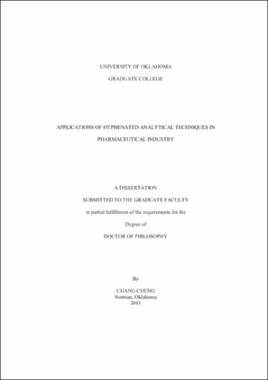| dc.contributor.advisor | Liu, Shaorong | |
| dc.creator | Cheng, Chang | |
| dc.date.accessioned | 2019-04-27T21:41:46Z | |
| dc.date.available | 2019-04-27T21:41:46Z | |
| dc.date.issued | 2011 | |
| dc.identifier | 999794602042 | |
| dc.identifier.uri | https://hdl.handle.net/11244/319364 | |
| dc.description.abstract | Analytical chemistry plays a critical role in pharmaceutical research and development. A typical analysis includes separating and identifying active pharmaceutical ingredients and impurities, determining the quantity of counterions, residual solvents, moisture, heavy metals in drug substances and drug products, and analyzing drugs and their metabolites in biological fluids. Analytical method development and validation are arguably the most important procedures in analytical research and development, because the qualities of drug substance and drug product are controlled by using analytical methods. This dissertation focuses on the application of various analytical techniques towards pharmaceutical industry. | |
| dc.description.abstract | An application of headspace gas chromatography/flame ionization detector (HSGC/FID) for determination of residual solvents in drug product has been studied in order to increase productivity of drug analysis in the pharmaceutical industry. The conditions of HS sampler and GC were optimized to make the HSGC method more sensitive, efficient and reproducible. The examples of real drug substance analyses demonstrate the broad application potential of this HSGC method in the determination of residual solvents in drug substances. | |
| dc.description.abstract | A simple, sensitive and robust liquid chromatography-tandem mass spectrometer (LC-MS/MS) method was developed and validated for highly polar aminoglycoside compounds gentamicin, kanamycin and apramycin. The effect of trichloroacetic acid (TCA) concentration on plasma protein precipitation and sample recovery was studied and an optimized concentration of 25-30% TCA were determined that gives the best sample recovery for aminoglycosides from rat plasma. | |
| dc.description.abstract | Simple, sensitive and robust LC-MS/MS methods were developed and validated for the determination of lipopeptide polymyxins and glycopeptide vancomycin in rat plasma. The effect of TCA concentration on sample recoveries was studied. | |
| dc.description.abstract | An efficient LC-MS/MS method was successfully developed and validated for determination of fifteen estrogens and metabolites in human serum. The sample derivatization procedures were optimized, and sample stability was assessed. The method was specific, accurate, precise, sensitive and linear within the calibration range. It had a comparable sensitivity to those from the typical published LC-MS/MS methods, while it had a much better LC separation efficiency for separating all of the fifteen dansylated estrogens and metabolites with a significantly reduced elution time. | |
| dc.description.abstract | Both CIEF and MALDI-MS are frequently used in protein analysis, but hyphenation of the two is not investigated proportionally. One of the major reasons is that the additives (such as carrier ampholytes and detergent) in CIEF severely suppress the MALDI-MS signal, which hamper the hyphenation of the two. A simple CIEF-MALDI MS interface is used and to explore its application in proteomics research. This study is to develop a simple means to alleviate the signal suppressing from CIEF additives, such as carrier ampholytes and detergent, on MALDI- MS signals. | |
| dc.format.extent | 213 pages | |
| dc.format.medium | application.pdf | |
| dc.language | en_US | |
| dc.relation.requires | Adobe Acrobat Reader | |
| dc.subject | Chemistry, Analytic | |
| dc.subject | Pharmaceutical industry | |
| dc.subject | Pharmacy--Research | |
| dc.subject | Drugs--Research | |
| dc.title | Applications of Hyphenated Analytical Techniques in Pharmaceutical Industry | |
| dc.type | text | |
| dc.type | document | |
| dc.thesis.degree | Ph.D. | |
| ou.group | College of Arts and Sciences::Department of Chemistry and Biochemistry | |
